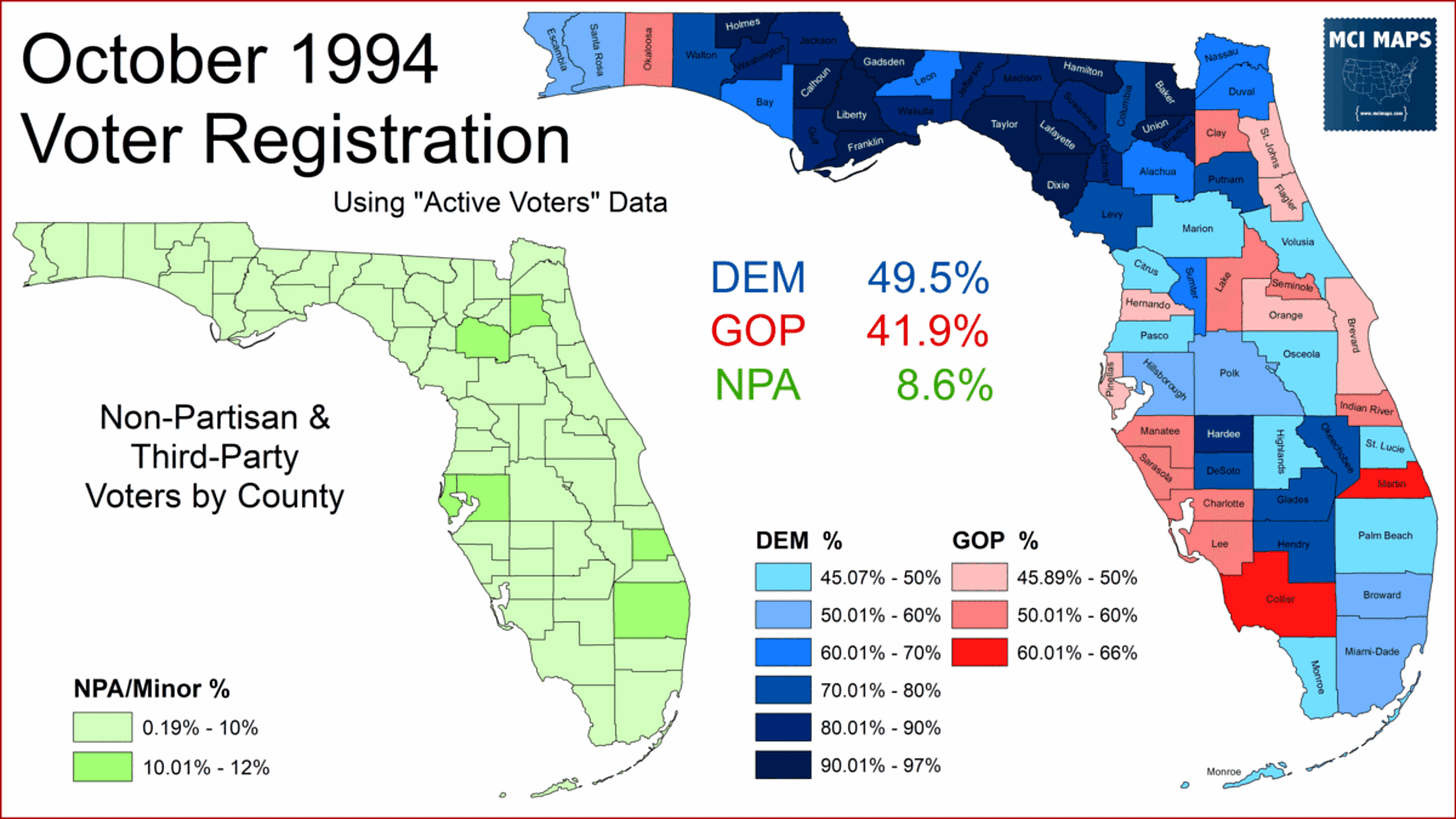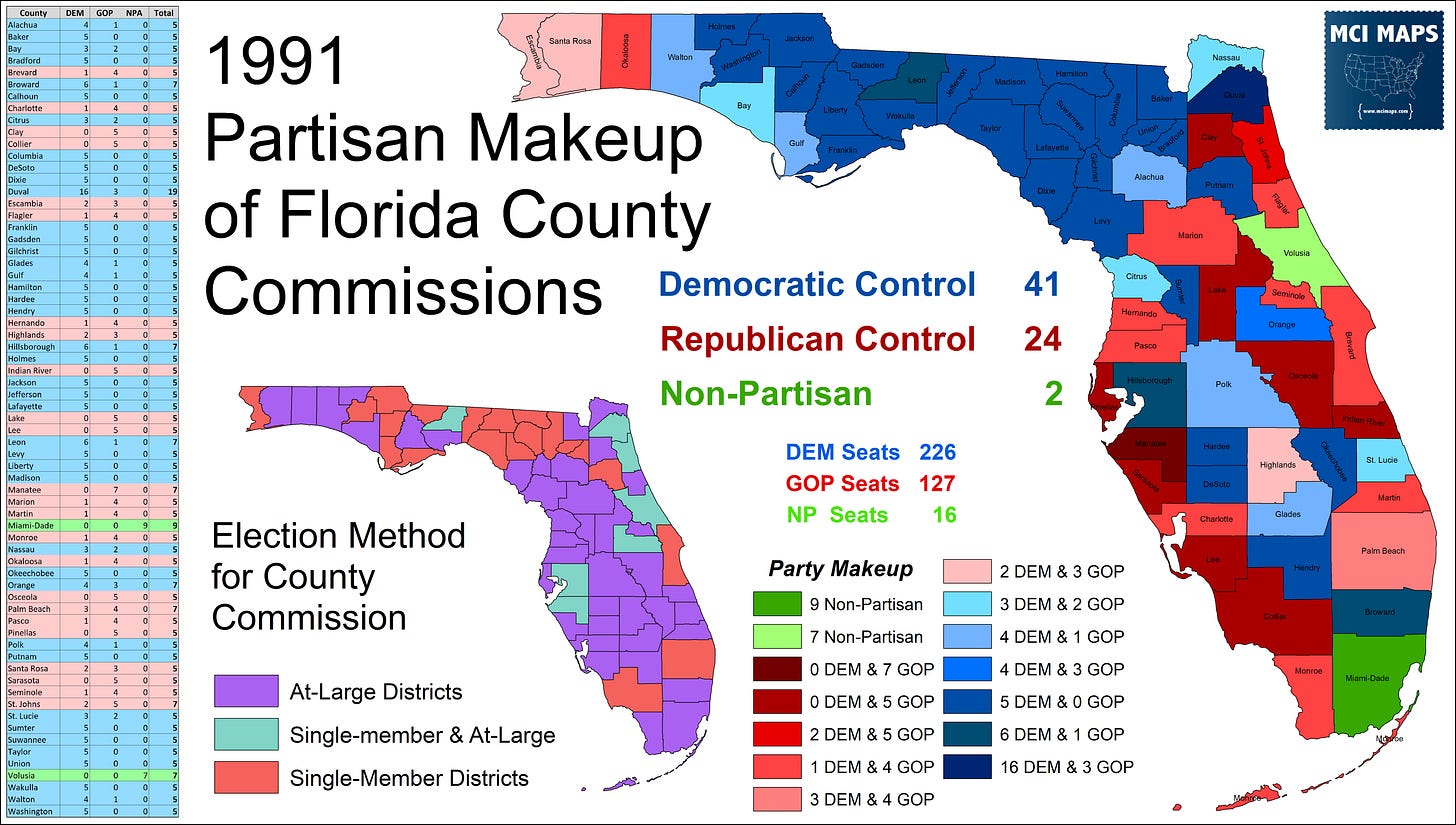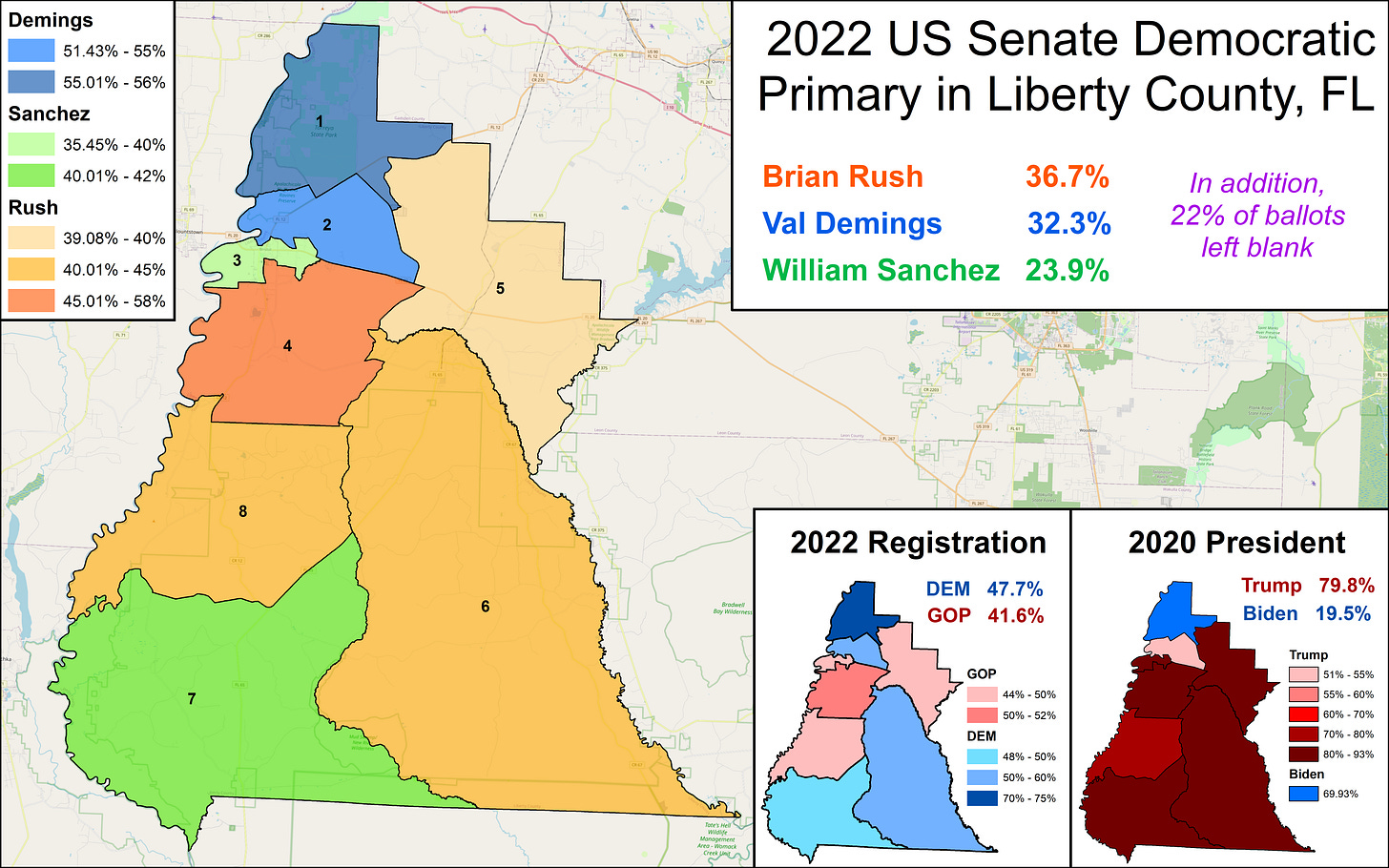Issue #75: The Twilight of the Florida Panhandle Protest Vote
Conservative "dixiecrats" are becoming formal Republicans
Yesterday, I wrote about the Florida Republican Party cementing its lead in voter registration for the state. In that article, one of the things I highlighted was the collapse of Democratic registration share in the Florida panhandle and farm counties. Historically, like much of the South and Appalachia, rural Florida voters were steadfast Democrats.
This has been slowly shifting for years, and today the rural counties of Florida are almost all GOP in registration. The GIF below shows registration in Florida from 1994 to 2022.
To be clear, the GOP takeover of registration is not just because of the rural county shifts. Democrats have major problems in Tampa and Southeast Florida as well, where small shifts equal larger vote totals.
For this article, however, I wanted to look more at these rural counties, and how their registration shifts are about to change Democratic primaries in the state.
The Conservative “Dixiecrats”
For Florida’s long history, its Northern counties have been dominated by conservative Democrats. In the 1950s and 1960s, these Democrats were known as the “Pork Chop Gang” - and they ran Florida politics. In 1966, Florida was overwhelmingly Democratic in registration, with the North Florida region being over 90% Democratic.
1966 is an important year to highlight because despite this registration gap, this was the first year that modern Florida elected a Republican as Governor. Claude Kirk won the state that year, doing very well in the panhandle, taking the votes of segregationist Democrats. This was also in an area where rural black voters were only starting to emerge from the effects of Jim Crow and take advantage of the Voting Rights Act.
Over the course of decades, Republicans at the top of the ticket would make strong inroads in the rural counties. However, while these counties would back people like Ronald Regan for President or Mel Martinez for Governor, they’d be almost universally Democratic down-ballot.
These Democrats were hyper conservative and often felt the national party (and eventually state party) had moved too far to the left for them, but they maintained a down-ballot democratic tradition. Republicans would make slow gains over time, but even as late as pre-2016, many counties remained Democratic-controlled despite being solidly GOP at the top of the ticket. Below is county commission control before the 2016 election.
These same counties, which maintained dominant Democratic voter registration, also had interesting primary results for top-of-ticket races. Several statewide Democratic primaries showed a history of the rural Dixiecrat counties giving votes to random opponents of the major candidates. Why was this? My belief was that since these rural dems show up to vote in the primary for their local offices, they begrudgingly voted for top-of-ticket primaries like Gov/Sen - even though they intended to vote GOP for those offices in November. As a result, they’d often throw their vote away or leave it blank. For example, it was not uncommon for a primary for Calhoun County Sheriff to have a higher vote total than for Governor; despite the races being on the same ballot.
The Protest Votes
In 2014, as Charlie Crist easily beat-back a primary challenge from Broward State Rep Nan Rich, I predicted that Rich’s best performance would be not in liberal pockets, but rather the Florida panhandle. I published around 1am the day before the primary. Sure enough, as Crist crushed Rich by 50 points, he lost many precincts in the rural-white democratic pockets.
Rich was a solid liberal candidate. However, she has little money to advertise. For the rural Democrats of North Florida, Rich was just a name going against that “flip flopper Charlie Crist.” In addition to the Rich protest votes, a large number of these democrats left the entire race blank, while sticking around for the down-ballot local races. The map below shows the undervote (aka blank) in the Governor primary.
The protest vote phenomenon is not just in Florida, its in many ancestrally Democratic states. I covered protests votes on my website multiple times, including…
A post-primary look for the 2014 Rich v Crist contest
Predicting a large protest vote in the 2016 West Virginia Primary
Looking at the protest votes in West Virginia and Kentucky’s 2016 primaries
Predicting a protest vote in the 2016 Florida Senate Primary
A post-primary look at the protest vote in the 2016 Florida Senate Primary
Looking at the protest vote in the 2018 US Senate primary in West Virginia
In fact, we saw this protest vote in this year’s August primary. While Val Demings secured 84% of the statewide primary vote, she did much worse in the rural counties; lossing two!
If you look back to earlier maps, these weaker Demings counties are all in that ancestral-Democratic area. Still, the loss of Liberty and Holmes is staggering. Both these counties are FAR less Democratic in registration than they used to be, and the protest vote would likely have been much higher if more of the old white “dixiecrats” still could vote in that primary.
The precinct map for Liberty really tells the perfect story. Precincts 1 and 2 have the largest African-American population (with 1 being maj-black), and those were the lone Demings precincts. The remaining precincts are all heavily white, deep red areas.
Liberty is on the verge of flipping registration. This county, which only has 4,400 voters, has a 100 Democrats edge right now. As more of its white Democrats switch to the GOP, the Democratic base will become increasingly African-American. The result will be a shrinking of protest votes.
The registration shifts will also lead to maps like the one below being less prominent. The map shows how Biden’s % of the vote compared with the DEM reg share of the vote cast. All the red is areas where Biden % was lower than the share of voters who registered with the Democratic party; while blue is him overperforming.
This map looks very similar for Charlie Crist in 2014, Hillary Clinton in 2016, and Barack Obama in 2008 and 2012. However, the amount of red on the map is lower now than in the past, and will continue to lessen as rural, white democrats become officially Republican.
The shifts in registration coincide with a notable weakening of the local Democratic dominance. Most of the rural, white counties today see Republicans controlling local offices. I actually intend to catalog that shift in some future articles.
The latest county to move away from electing local Democrats was Liberty itself. Liberty County’s 2020 elections marked the first time it had voted GOP for local office in history.
The realignment always works its way down-ballot. This year, the two Liberty commission districts saw both candidates files as Republicans, and won unopposed. 2022 was the first year no Democrat filed for partisan local office in Liberty.
Looking Ahead
After the general election, I intend to delve even more into Florida’s voter registration history and the legacy of its conservative democratic history. Keep an eye out for more history in 2023.














Mathew, I very much enjoy reading your reports. One shift that was seismic for me was when President Lyndon Johnson signed the Civil Rights Act in 1964 and integrated the schools in Jacksonville, FL. I remember a huge shift of whites from Democrats to Republicans. Was wondering how that compares to today's shifts?